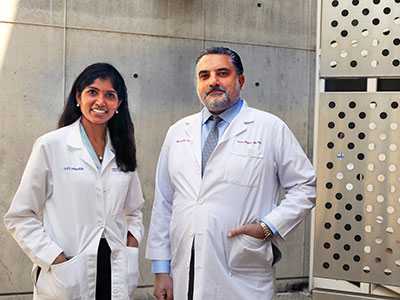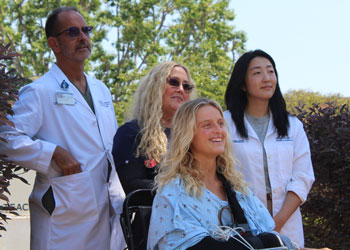
Skin Cancer Care
At UCI Health, our skin cancer specialists provide research-based treatments, advanced surgeries and preventive screenings to protect your health.
More than 5 million people are diagnosed annually with skin cancer —making it the most common cancer in the US.
At UCI Health, our expert skin cancer specialists diagnose, stage and treat all skin cancers, from simple to complex and common to rare.
Our approach to skin cancer care
If caught early, most skin cancers are easily treatable. At UCI Health, our skin cancer specialists offer you expert care for both simple and complex skin cancer cases.
We work closely with your primary care physician and dermatology providers, ensuring a seamless transition from initial diagnosis to specialized treatment.
At your first appointment, you can expect a thorough evaluation of your skin and any concerns you may have. Our team will take the time to listen to your medical history. We’ll perform any necessary tests to ensure an accurate diagnosis.
Comprehensive treatment options
Our board-certified dermatologists use the latest techniques to help you achieve the best possible outcomes. We offer a full range of treatments for skin cancer and precancerous skin conditions, including surgery, targeted therapy and advanced radiation options.
Immunotherapies in particular have made a huge impact in treating skin cancer, especially melanoma. These treatments boost your body's immune system to help it recognize and attack cancer cells. By blocking certain proteins that stop immune responses, immunotherapies have improved survival rates and reduced the chances of cancer coming back.
Immunotherapy is increasingly being used to treat lower stages of skin cancer as well—not just advanced cases. This means patients diagnosed earlier can also benefit from these innovative treatments, helping to prevent progression and improve outcomes right from the start of their journey.
Expect a collaborative experience
We work together to ensure you receive comprehensive care throughout your treatment journey, from initial evaluation through follow-up care.
Your skin health matters. Through early detection and expert care, we’re here to support you every step of the way.
Why choose UCI Health for skin cancer care?
We use the latest diagnostic technologies, including dermoscopy and SIAscopy, allowing for earlier and more accurate detection of skin cancers. This can lead to more effective treatment options and better outcomes for you.
Our skin pathologists at the UCI Health Dermatopathology Laboratory provide immediate consultations and assessments of complex skin conditions. Our dermatopathologists also provide vital second opinions, sometimes uncovering a previous misdiagnosis.
Quick and accurate diagnoses are crucial for determining the right treatment plan, giving you peace of mind.
Our team of plastic surgeons focus on minimizing scarring and improving the overall look of the skin, which can be especially important for visible areas like the face. Their work helps you not only recover physically but also boosts your emotional well-being.
As part of Orange County's only university medical center, we have access to the UCI Health Chao Family Comprehensive Cancer Center, the region's only National Cancer Institute-designated comprehensive cancer center. This affiliation means you have access to leading-edge therapies and comprehensive care in one location.
Our specialists participate in NCI-sponsored clinical trials, giving you access to the latest drugs and treatments before they are widely available. This can provide you with more options for managing your condition effectively.
An unfortunate and common side effect of certain skin cancer surgeries and treatments is lymphedema. When lymph nodes are removed or damaged, it can disrupt the normal flow of lymph fluid, leading to swelling in the affected area. One of our plastic surgeons, Gordon Lee, is an expert in performing lymphatic venous bypass, a surgical procedure that helps redirect lymph fluid around blocked areas, much like a bypass works in the heart.
Looking for more options?
View all clinicians
If your skin develops a new mole or pigment, don’t wait
At UCI Health, we’re here to answer your questions and support you. If you have skin cancer concerns or need an evaluation, please contact us today.
Call 949-824-0606 to learn more about skin cancer services at UCI Health.

Find a cancer clinical trial
Talk to your doctor to see if a cancer clinical trial is right for you.
Featured News Stories

Thousands take the Anti-Cancer Challenge, raising over $1 million for critical research
A record number of people joined the ninth annual Anti-Cancer Challenge to ride, run and walk to support cancer research.

Seeking a solution for advanced gastric cancer

Ventura surf instructor goes home after arm is saved at UCI Health — Orange
Featured Blog Posts

Gastric cancer survivor credits novel clinical trial therapy

'Get your mammogram,' urges breast cancer survivor
Annual screenings can detect breast cancer early, when it is most treatable, says UCI Health breast cancer survivor Barbara Cortez.

Appendix cancer survivor relishes life and giving back
Grateful to be alive, Kat Kitchen is volunteering for the UC Irvine Anti-Cancer Challenge, where she and her daughter will offer anti-inflammatory light therapy.
Upcoming Events
Ride, run and walk for cancer research
12-1 p.m.
Preparing for Surgery — Mind, Body and Spirit
4-5 p.m.
Young Adult Cancer Support Group
The Young Adult Cancer Support Group provides help and support for individuals with cancer between the ages of 18 and 35 receiving active cancer treatment.




